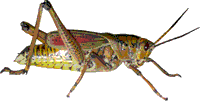Entomology Collections, General

Entomology Papers from Other Sources
Document Type
Article
Date of this Version
1988
Abstract
The interaction of feeding by a grass bug, Irbisia pacifica (Uhler), and drought stress on growth of Great Basin wildrye, Leymus cinereus (Scrih. & Merr.) Love, and intermediate wheatgrass, Thinopyrum intermedium (Host) Barkw. & D. R. Dewey, was studied in the greenhouse. At peak production, control plants of Great Basin wildrye had more than twice as much green leaf area per tiller than bug-infested ones, and intermediate wheatgrass controls had three times as much as the bug-infested plants. Total leaf area of control plants also exceeded that of bug-infested plants. Watered plants of both species recovered very little after bugs were removed. Drought conditions augmented the reduction in green leaf area on previously bug-infested plants of Great Basin wildrye but not on previously infested intermediate wheatgrass plants. Thus, when plants were well watered, bug feeding affected growth of intermediate wheatgrass more than growth of Great Basin wildrye. However, when plants were subjected to bug feeding and drought stress, the vigor of Great Basin wildrye was reduced more than that of intermediate wheatgrass. For both species, the potential forage for livestock consumption was lost because of direct damage by bug feeding as well as indirect effects on the acquisition or allocation of plant resources to growth.


Comments
Published in Ann. EntomoL Soc. Am. 81(4): 599-604 (1988).